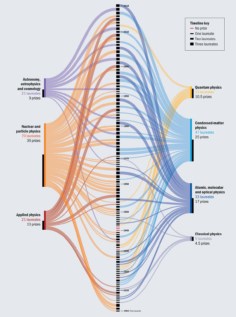
Tomorrow, the winner(s) of this year’s Nobel Prize for Physics will be announced. This will the 14th Nobel prize that I have covered for Physics World, and I can honestly say that the excitement has never waned.
A big challenge for journalists on Physics World, however, is coming up with new ways of creating a bit of “sizzle” in the run-up to the announcement. This is difficult because unlike some other prizes, there is no public shortlist for the Nobel prize to whet the appetite. Indeed, who has been nominated and the deliberations of the Nobel committee are kept secret for at least 50 years – so it is impossible to know who is in the running and very difficult to understand how decisions are currently being made by the committee.
However, I am not complaining about this information deficit. I think it is one of the many things that keeps the Nobel prize fresh and exciting every year.
Last year I was very fortunate to gain some insights into the selection process when I interviewed the Swedish physicist Lars Brink, who served on the Nobel Committee for Physics on eight separate occasions. So if you are keen to learn about the finer points of how winners are selected, check out my article “Inside the Nobels: Lars Brink reveals how the world’s top physics prize is awarded”.
Predicting winners
One way of generating a bit of excitement in the run-up to the Nobel is to predict who will bag the prize. The problem with predictions is that mine are almost always wrong. And after a few years, I also run out of new people to predict as winners.
To see how good our Physics World predictions have been, I looked back at a blog I wrote in late September 2009 (“Nobel predictions”). The predictions were made by Physics World editors and the Nobel laureate Albert Fert. Here are the 13 predictions we made (all men, I’m afraid) and the years that some of them actually won a Nobel prize: Alain Aspect, David Wineland (2012), Peter Zoller, Juan Ignacio Cirac, Anton Zeilinger, Michel Mayor (2019), Didier Queloz (2019), Andre Geim (2010), Konstantin Novoselov (2010), Yakir Aharanov, Michael Berry, Saul Perlmutter (2011) and Brian Schmidt (2011). That is better than 50%, so maybe I am underselling our ability to predict winners (I say “our”, because I only got one right).
Not content to rely on intuition to pick winners, in 2014 I took a close look at whether there is a temporal pattern in how prizes are awarded. I divided physics into seven disciplines and created an infographic that shows when prizes were awarded in those fields.
Quantum information this year?
The figure “Nobel Prize disciplines timeline” is version of the infographic updated to 2019 and if you squint at it for long enough you may convince yourself that there is a pattern in the prizes. For example, there has not been an award in the field of quantum physics for eight years – so, my only prediction for this year will be a prize to physicists working in the field of quantum information.

Another reasonable bet is that at least one of the 2020 laureates will be an immigrant. That prediction comes courtesy of our 2015 Nobel sizzle, when I created an infographic that reveals that more than 25% of physics laureates can be classed as immigrants. That was updated in 2019 and you can read more in “More than one-quarter of physics Nobel laureates are immigrants, reveal updated infographics”.
I think that our best bit of Nobel sizzle so far was last year’s series of pieces about our favourite Nobel prizes. My pick was the 1982 prize to Kenneth Wilson “for his theory for critical phenomena in connection with phase transitions”. I have always been fascinated by phase transitions, but I have to admit that it was a bit daunting to try to describe Wilson’s work in a few hundred words: (“My favourite Nobel prize: a universal theory for phase transitions”).
This year we are focussing on people who we think missed out on a Nobel. You can find those pieces on the Physics World website in a panel called “Overlooked for the Nobel”. I have contributed two pieces to this series: one championing the physicists at CERN who discovered the Higgs boson, and the other asking why the Chinese-American physicist Chien-Shiung Wu did not win a Nobel for her pioneering measurement of parity violation.



